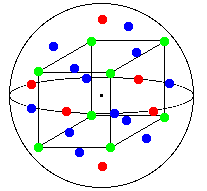If p is a fixed point of an element g ∈ G and h is any element of G, then hp is a fixed point of hgh -1 ∈ G and hence is a pole.

We divide the set of poles into orbits: subsets of the form Gp for some pole p.
| Previous page (Symmetry groups of Platonic solids) | Contents | Next page (Full finite symmetry groups in 3 dimensions) |
The main result of this section is to classify all such groups.
A finite symmetry group cannot contain translations, glides or screws and so arguing as before, such a group must fix some point which we may as well take as the origin. We are then reduced to considering the linear case.
We start groups of rotations and with the following result about linear groups.
Theorem
Any finite subgroup of SO(3) is either a cycle group Cn a dihedral group Dn or one of the groups of a Platonic solid.
Proof
Let G be a finite subgroup of SO(3) with order n.
Then G acts on the unit sphere S and each rotation has two fixed points: its poles. We will look at the set of all poles on S (a finite set).
Lemma 1
Every element of G maps a pole to a pole.
Proof of lemma
If p is a fixed point of an element g ∈ G and h is any element of G, then hp is a fixed point of hgh -1 ∈ G and hence is a pole.
We divide the set of poles into orbits: subsets of the form Gp for some pole p.
Lemma 2
If p is a pole of an element of G of maximal order m then the orbit of p contains n/m elements.
Proof of lemma
The subgroup H of G which leaves p fixed has m elements. So G is a union of cosets g1H, g2H, ... , grH with r = n/m.
All the elements in a coset giH will move p to the same point gip for i = 1, 2, ... , r.
Note that if i ≠ j then gip ≠ gjp since if gip = gjp then gi-1gjp = p and so gi-1gj ∈ H and so gi and gj would represent the same coset.
Hence the orbit of p is the set {g1p, g2p, ... , grp} as required. 
The n - 1 non-zero rotations in G consist of m - 1 rotations for each pair of poles.
That is 1/2 (m - 1) n/m for each orbit.
Hence n - 1 = 1 /2 n( (m-1)/m) where the summation is over the orbits ⇒ 2 - 2 /n =
(m-1)/m) where the summation is over the orbits ⇒ 2 - 2 /n =  (1 - 1 /m ).
(1 - 1 /m ).
Since m ≥ 2 we have 1 - 1/m > 1/2 and so we can only have 2 of 3 orbits if G is non-trivial.

 Look at the case of Sd(Cube) for which |G| = 24.
Look at the case of Sd(Cube) for which |G| = 24.
| Poles are: | Rotation by: | |Orbit| | Geometric feature | |G| |
| Red orbit | ±π/2, π | 6 | face centres | 9 |
| Blue orbit | ±2π/3 | 8 | corners | 8 |
| Green orbit | π | 12 | edge centres | 6 |
Remark
Note that we are used to thinking of Dn as a group acting on R2 and containing some reflections. As a subgroup of I(R3) the elements of order two are not reflections but rotations by π.
| Previous page (Symmetry groups of Platonic solids) | Contents | Next page (Full finite symmetry groups in 3 dimensions) |